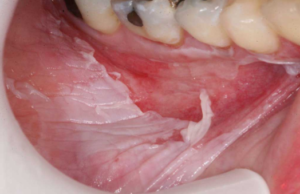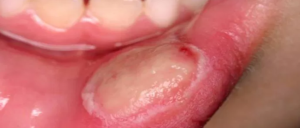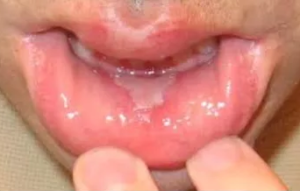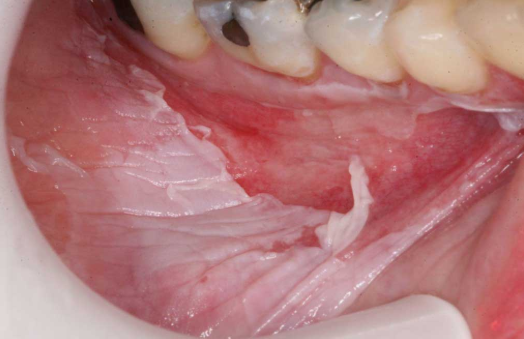what causes inside of mouth to start peeling? This post provides you with the images of how the peeling appears, the causes and treatment options on how to get rid of the peel once it starts.

Peeling of inside mouth can be as a result of an array of causes. When you notice your inside of mouth start to peel from time to time, it could be because you’re having a mild allergic reaction to your toothpaste or a an auto immune disorder. To other many disease or lifestyle activity like smoking.
Sometime, the infection could be as result of a serious medical or dental complication such as the following; Stomatitis, Oral psoriasis, Canker sores, Mouth ulcers or even Stevens-Johnson syndrome below are more causes, symptoms and treatment option for other causes of inside of mouth peeling.
Pictures of skin inside mouth peeling
Find below a picture to help you understand the cause of your symptoms. Throughout the post, we have more images to provide you a visual aid on the cause of peeling inside the mouth.


Causes of skin peeling inside mouth
There are an array of different causes that would result to the inside of mouth peeling. Though most are believed to be harmless, the discomfort and pain caused as a result of your mouth peeling can be unbearable. Most of the time the peeling of inside mouth stops on its own, but if this fails to happen you need to see your dentist for effective medication and treatment.
1. Allergic reaction of toothpaste
It is possible for your inside mouth to start peeling after brushing your teeth. Mild allergic reaction to toothpaste is one of the reason for this to occur. Most of the mouthwash contain alcohol contents. It has been found that continuous use of mouthwash with alcohol could lead to infection such as ulcers and at extreme oral cancer.
Listerine has been found to be the most common mouth wash with alcohols. It is only to be used when required as it has been shown to improve gingivitis and even help heal gum disease. You need to take note, it is very strong and should not be used in excess. When used in excess, the alcohol in it could even burn your inside mouth causing peeling. To avoid this, you can dilute the Listerine with water before use. The effect of the alcohol in the Listerine has been found to include
- drying your mouth and lips,
- alter the sense of test
- lead to tissue sloughing (inside of mouth peeling)
What then do you need to do to prevent inside mouth peeling from using toothpaste? The answer is very simple, for a start, you need to discontinue using the toothpaste that prove allergic to you. Try an alternative toothpaste and note if there has been an improvement or the peeling persists.
If after a week the peeling continues, and the alternative toothpaste still cause the peeling in your mouth, you need to see your dentist as soon as possible. Otherwise you can stick to using toothpaste that has fluoride to help strengthen and strengthen against cavities.
2. Auto immune disorder
It is common for you to have inside of mouth peeling as a result of auto immune disorder. This is as a result of blisters developing inside your mouths mucus membrane lining as a result of your body attacking its own skin tissue. The common cause of auto immune disorder include:
- Pemphigus, an uncommon, sometime fatal disease causing blisters in the mouth
- Ballous pemphigoid a less dangerous disease whose blisters are itchy, hard and tight. The skin between the blisters is red and maybe swollen.
- Dermatitis herpertiformis, a chronic inflammatory disease caused by sensitivity or allergy to gluten.
According to the American Autoimmune Diseases Association, auto immune diseases affects up to 50 million Americans. It has also been found to be a chronic condition with no known cure. Nevertheless, treatment involves attempt to control the disease and reduce the severe symptoms. To alleviate the disease, you can do the following;
- Eat balance diet
- Regular exercises
- Give yourself an ample time to rest
- Take a moderate amount of vitamin supplements
- Reduce excessive sun exposure
3. Stevens-Johnson syndrome
Stevens-Johnson syndrome is a rare but serious disorder that affects the skin. It is usually caused by an adverse reaction to certain medication. It also possible for the Stevens-Johnson syndrome to be caused by an infection.
It begins with flu like syndrome, followed by a red rash that spreads and form blisters. The affected parts will eventually die and start to peel off. You should see your health care provider as soon as possible since the condition is a medical emergency that calls for a lot of care. The treatment mostly aim at identifying the underlying cause, controlling the symptoms and preventing future complication.
It is common for people with Stevens-Johnson syndrome to experience symptoms such as:
- Felling generally unwell
- Severe headaches
- Joint pain
- Fever
- cough
After sometime of experiencing the above symptoms, rash may appear inside your mouth, this may lead to the death of tissue in the mucus membrane causing the peeling inside your mouth. The rash usually appears as a target, darker in the middle and lighter in the outside. If you brush your teeth during this stage, it may cause the development of blisters and ulcers which after busting leaves painful sore. The lining of your throat may become blistered, this can make swallowing painful and lead to serious problem such as dehydration.
Early medication and treatment of this condition is advised. If left unattended, the symptoms could worsen and lead to a life threatening infection. Your health care provider will refer you to an intensive care unit or burn section for careful monitoring and treatment.
The medication would include;
- Strong painkillers to help ease the pain in raw area of the skin and mucus membrane.
- Skin moisturizer, this can be an inhaler or liquid
- Replacement fluids, this are nutrients containing fluids and tablets that help repair the ruptured membrane in your mouth.
- General antibiotic if blood poisoning is detected during your blood test.
- Mouthwash containing anesthetic may be prescribed to numb your mouth and make swallowing easy.
4. Peeing inside mouth after brushing your teeth
Is it possible for my mouth to peel after brushing? Yes, putting a lot of force while brushing leads to cracking of your mucus membrane in the mouth. If you are allergic to toothpaste, the reaction could lead to your inside mouth peeling.
If you stop brushing for a while, the peeling might stop, but if the peeling does not stop then you need to see you dentist as soon as possible. Avoiding acidic foods and drink might also be necessary giving that these kind of food can worsen the situation and make the pain more severe.
5. Stomatitis
Stomatitis is the inflammation of the mucus lining of the mouth. It is a painful condition associated with redness, swelling and occasionally bleeding. As the swelling happens, the expansion and contraction of the lining results in the inside of mouth peeling. It is common for the inflammation to be as a result of;
- the condition in the mouth such poor hygiene,
- burns from hot foods and drinks
- A medical condition affecting the entire body.
- Allergic reaction of the body
It is very common for children to get stomatitis at any time of their growth. If you notice your child has developed inflammation in the mouth you need to see a pediatrician who will examine him and establish the real cause of the inflammation to help in early medication and avoid spreading to other parts of the body.
Depending with what is causing the stomatitis, it may be contagious or not. Herpes stomatitis in children is considered contagious. The exposure maybe through kissing and playing in close contact to one another.
Treatment of stomatitis is based on treating the underlying cause of the infection. Avoid the causing factor is also fundamental in treatment of the stomatitis, you need to do the following,
- Uphold local cleansing of the inner mouth
- Maintain good oral hygiene by regularly brushing your teeth
- Avoid sharp food (especially for kids) such as peanuts and fries
- Careful choice of toothpaste should be considered to avoid allergic reaction
6. Oral psoriasis
Oral psoriasis mostly affects the torso and extremities, it can also cause lesion on the mucus membrane including the tongue, lips and inside mouth peeling. The Journal of Dermatological Case report start that it most often appear as red spots and flaky regions on the lips before it can appear anywhere else.
When you start to develop lesions in your mouth, you need to seek the help of your dentist who will diagnose you and identify the actual cause of the lesions. You need to establish that the lesions are due to psoriasis and not any other health problem. This will help in completely treating the peeling inside mouth due to psoriasis.
According to the European Journal of General dentistry, oral psoriasis can manifest as general tongue lesions, form of yellow or red spots, whitish area or semitransparent plaques. With oral psoriasis, sores can appear on the palate (mouths roof), inside the cheeks or the lips as well. It is not common for the disease to affect the gum. You need to see your dentist to avoid the spread of the infection to other parts of the body.
If you notice the following symptoms, the cause of inside of mouth peeling could most likely then be oral psoriasis,
- Red patches with white borders
- Redness of the mucus membrane in mouth
- Peeling gums
- Ulcers in mouth
Once your health care provider has pursued a biopsy for definitive diagnosis, he/she may prescribe treatment which may include topical cortical steroids or oral medication that will help control your body’s auto immune response.
7. Ora cancer
Oral cancer also known as mouth cancer occurs when a tumor develops inside the lining of your mouth, that is the mucus membrane covering your mouth throat and digestive lining. It can also be in the surface of the tongue, the inside of cheeks and the roof of mouth all the way to the throat, gums and lips.
Oral cancer occurs when cells on your lips or mouth develops changes in their DNA, it is this mutation that allows the cancer to grow and divide causing healthy cells to die, this commonly results into the inside of mouth peeing as the lining dies off and starts to fall off. It mostly begins in the flat, thin cells that line the lips and the inside of mouth.
The cause of the mutation is not clearly know, but over time doctors have identify factors which may increase the risk of oral cancer. They are the following.
- Continuous use of tobacco products
- Heavy alcohol consumption
- Continuous exposure to sun
- A weaken immune system
- Also a sexually transmitted virus-Human papilloma Virus
Please visit your health care provider as soon as possible to advice on the best possible medication for treatment. The symptoms to watch out for are:
- Sores and mouth ulcers that fail to heal within a week.
- Numbness and loss of test
- White patches on the mouth lining
- Unexplained lumps in the mouth
- Lumps in the neck
8. Oral Leukoplakia
Leukoplakia also called leucoplakia refers to a condition where areas of keratosis appears as firmly attached white patches on the mucus membranes of the oral cavity. Oral leukoplakia is defined as “a predominantly white lesion of the oral mucosa that cannot be characterized as any other definable lesion”
Oral leukoplakia isn’t normally dangerous but it could be serious at times. If you start experiencing severe itching then you need to see your doctor as soon as possible. Although most are noncancerous, some may show early signs of cancer. The cause for this kind of infection is not known, it is thus advised to see your dentist when you have unusual persistent changes in your mouth.
Oral leukoplakia has various appearance, changes mostly occur on your gums, the inside of your cheeks and at times your tongue. The appearance of the leukoplakia is mostly as follows:
- White or gray patches
- Irregular, flat—texture
- Some area of the mouth can be hardened
- Your mouth can have raised, red lesions likely to show precancerous changes.
For those with weak immune system (due to medication and disease mainly HIV/AIDS) may experience a different type of leukoplakia called hairy leukoplakia. It causes fuzzy, white patches that resemble ridges in their tongue. It is easily mistaken for an oral rash. This could be a reason for the inside of mouth peeling.
9. Burning mouth syndrome
Burning mouth syndrome is an ongoing chronic medical condition or recurrent burning of mouth without any obvious cause. It is a burning sensation where no underlying medical or dental cause cannot be identified and has no signs in the mouth most of the times. Otherwise, the discomfort caused may affect the tongue, lips, inside the check and the roof of the mouth. The burning sensation rangers from mild and can be severe at other times.
Burning mouth syndrome may at time comprise subjective xerostomia. Xerostomia is a dry mouth sensation where no cause can be found, the causes would otherwise include conditions such as reduced salivary flow.
When you have a burning sensation in the mouth, it could be a symptom of another underlying disease. This is confirmed when systemic factors are found to be implicated, this therefor means that the condition seizes to be burning mouth syndrome. According to the international Association for the study of pain, burning mouth syndrome is “a distinctive nosological entity characterized by unremitting oral burning or similar pain in the absence of detectable mucosal changes”
Inside of my mouth is peeling and hurts
Is the inside of mouth peeling and hurts? Sometimes mouth sores can be annoying and painful. This could be besides the sores being harmful and causing the inside of mouth to peel. If your mouth hurts a lot and the peeing does not go away after a week or so, you need to see your dentist for diagnosis and early treatment.
The most common cause of inside of mouth peeling and hurting is psoriasis. It often affects the torso and extremities, and it is most likely to cause lesions on the mucus membrane, including the tongue, lips, and most commonly inside the mouth. According to the Journal of Dermatological case Reports, in rare cases, the lesions may appear as red spots and flaky regions on the lips before it appears elsewhere on the body.
In general, psoriasis in the mouth is uncommon. If you have psoriasis and experience lesions in your mouth, you need to speak with your dentist to be sure that the symptoms are related to the psoriasis and not any other infection. The other symptoms to cheek for before you see your doctor will include the following:
- White sores inside mouth that fail to go away.
- Lumps or small pimples in mouth lining
- At times your lips my dry and crack
- Peeling gums
- Ulcers
Treatment of inside mouth peeling
There exist no perfect medication for the treatment of peeling inside mouth. The best medication would be to treat the underlying cause of the peeling inside of mouth, once you are diagnosed, and the underlying cause of the peeling is found. The dentist will established the symptoms and match them to one of the causes discussed above and he will be able to prescribe the medication for the best treatment of the peeling.
The dentist might prescribe a topical anesthetic that will help relieve the pain of the mouth sores. Other over the counter pain medication such as aspirin might also help relieve the pain. Other pain medication such as acetaminophen, ibuprofen (Advil, Motrin IB) may also relieve general discomfort.
It is common for the peeling to go away some days but if you have your mouth peeling, and it fails to go away, then you need to see your dentist as soon as possible. Treating the underlying cause of the peeling is key to treating the problem.
How to stop inside of mouth peeling – Home remedies
Apart from treating the peeling of inside mouth In the hospital, there are some simple home remedies you could apply at home that will help you sooth the mucus membrane and reduce the pain, you should take note, that this is not for completely treating the peeling but temporarily easing the pain before you finally get to the dentist.
It is also possible for some foods to irritate the blisters and sore caused by the peeling in the mouth, tongue and throat. The following remedies will help in easing the blisters soreness and irritation. You could try one or a combination of the following.
a) Coconut oil
Coconut oil is rich in anti-inflammatories, antimicrobial and generally healthy when eaten. It is the best remedy for getting rid of canker sore causing white bumps on tongue. All you need to prepare this remedy is a fresh coconut fruit.
To make the remedy, do the following:
- Dab a moderate amount of coconut oil using a swab onto the sores.
- An alternative is, you can put a considerate amount of coconut oil in your mouth and leave it for 10 minutes before throwing it out
- Repeat this twice daily till the peeling and the white bumps on tongue disappear.
b) Aloe rinse
Aloe Vera is consider among the best, if not the best soothing plants of all. The gel wields a lot of anti-inflammatory, anti-itching, antibacterial properties that are very important in the healing process of white bumps on tongue and peeling inside mouth.
Star the aloe Vera gel in a half full cup of water and gently stir to mix. Swish the mixture over the sores three time in a day to ease the pain and facilitate healing of the sores.
c) Wax cap
For sore that keep rubbing against you teeth or are irritated by the dentures, putting a little wax “capping” over the surface of the sores can really reduce the irritating friction. You need to make the max thicker enough so that it does not just get around the brace and stuck
Do the following;
- Melt down a beeswax and coconut oil and allow them to mix
- Allow the mixture to cool
- Gently press dollop over the edge of the teeth to prevent the sores from rubbing
d) Honey rub
Honey has antibacterial properties and potential anti-inflammatory qualities to. Raw organic honey thus makes an excellent soothing coating for sore throats and canker sores in your mouth. If honey is placed on the white bumps on tongue it could help relieve the pain and speed in the healing process all together.
All you need to do is, swish some warm water in your mouth, then apply a thick layer of raw organic honey, you can do this with your fingers or a spoon. Let the coating last for around 10 minutes, before rinsing it out. Do this twice in a day and the result will be optimal.
e) Chamomile tea bag
Chamomile consist of several daisy-like plants commonly used to induce sleep, promote relaxation and help with digestion. A chemical compound- bisabolol is found naturally in German chamomile has been found to have anti-inflammatory and antiseptic properties. It is this properties that will help reduce the pain caused by sore throats and also help speed the healing process of the white bumps on tongue.
What you need to prepare this remedy :
- Soak the tea bag in water for 3 minute
- Fresh drinking water.
- a tea bag of chamomile or a tea spoon of dried flowers wrapped in a clean cloth
- After soaking place it directly against the sores for 5 minutes
- Repeat this twice daily for optimal results
Sources and references:
- http://www.webmd.com/oral-health/guide/dental-health-leukoplakia#1
- http://www.nhs.uk/conditions/cancer-of-the-mouth/pages/introduction.aspx
- http://everydayroots.com/canker-sore-remedies
- http://www.skincareorg.com/mouth-peeling/peeling-mouth-inside-of-mouth-peeling-stop-skin-peeling-roof-mouth-gums-cheeks/
- http://www.enkivillage.com/inside-of-mouth-peeling.html

